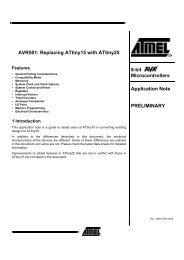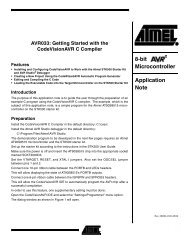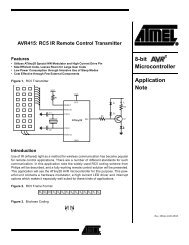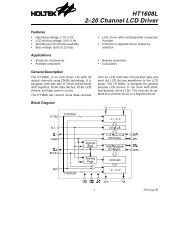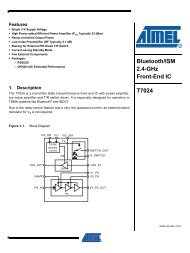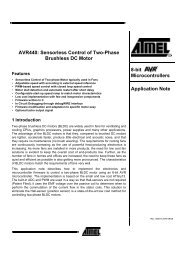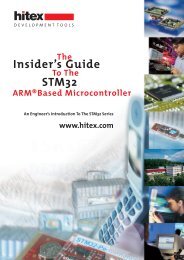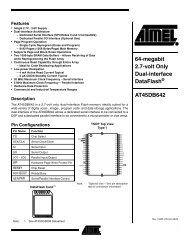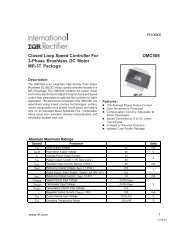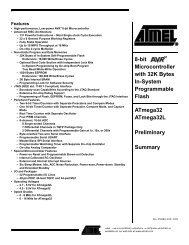Preliminary C8051F120/1/2/3 C8051F124/5/6/7 - KEMT FEI TUKE
Preliminary C8051F120/1/2/3 C8051F124/5/6/7 - KEMT FEI TUKE
Preliminary C8051F120/1/2/3 C8051F124/5/6/7 - KEMT FEI TUKE
Create successful ePaper yourself
Turn your PDF publications into a flip-book with our unique Google optimized e-Paper software.
<strong>C8051F120</strong>/1/2/3<br />
<strong>C8051F124</strong>/5/6/7<br />
<strong>Preliminary</strong><br />
ble at the Port pins of the device. Also note that the Crossbar assigns pins to all associated functions when a serial<br />
communication peripheral is selected (i.e. SMBus, SPI, UART). It would be impossible, for example, to assign TX0<br />
to a Port pin without assigning RX0 as well. Each combination of enabled peripherals results in a unique device<br />
pinout.<br />
All Port pins on Ports 0 through 3 that are not allocated by the Crossbar can be accessed as General-Purpose I/O<br />
(GPIO) pins by reading and writing the associated Port Data registers (See Figure 18.10, Figure 18.12, Figure 18.15,<br />
and Figure 18.17), a set of SFR’s which are both byte- and bit-addressable. The output states of Port pins that are allocated<br />
by the Crossbar are controlled by the digital peripheral that is mapped to those pins. Writes to the Port Data registers<br />
(or associated Port bits) will have no effect on the states of these pins.<br />
A Read of a Port Data register (or Port bit) will always return the logic state present at the pin itself, regardless of<br />
whether the Crossbar has allocated the pin for peripheral use or not. An exception to this occurs during the execution<br />
of a read-modify-write instruction (ANL, ORL, XRL, CPL, INC, DEC, DJNZ, JBC, CLR, SETB, and the bitwise<br />
MOV write operation). During the read cycle of the read-modify-write instruction, it is the contents of the Port Data<br />
register, not the state of the Port pins themselves, which is read.<br />
Because the Crossbar registers affect the pinout of the peripherals of the device, they are typically configured in the<br />
initialization code of the system before the peripherals themselves are configured. Once configured, the Crossbar registers<br />
are typically left alone.<br />
Once the Crossbar registers have been properly configured, the Crossbar is enabled by setting XBARE (XBR2.4) to a<br />
logic 1. Until XBARE is set to a logic 1, the output drivers on Ports 0 through 3 are explicitly disabled in order<br />
to prevent possible contention on the Port pins while the Crossbar registers and other registers which can<br />
affect the device pinout are being written.<br />
The output drivers on Crossbar-assigned input signals (like RX0, for example) are explicitly disabled; thus the values<br />
of the Port Data registers and the PnMDOUT registers have no effect on the states of these pins.<br />
18.1.2. Configuring the Output Modes of the Port Pins<br />
The output drivers on Ports 0 through 3 remain disabled until the Crossbar is enabled by setting XBARE (XBR2.4) to<br />
alogic1.<br />
The output mode of each port pin can be configured to be either Open-Drain or Push-Pull. In the Push-Pull configuration,<br />
writing a logic 0 to the associated bit in the Port Data register will cause the Port pin to be driven to GND, and<br />
writing a logic 1 will cause the Port pin to be driven to VDD. In the Open-Drain configuration, writing a logic 0 to the<br />
associated bit in the Port Data register will cause the Port pin to be driven to GND, and a logic 1 will cause the Port<br />
pin to assume a high-impedance state. The Open-Drain configuration is useful to prevent contention between devices<br />
in systems where the Port pin participates in a shared interconnection in which multiple outputs are connected to the<br />
same physical wire (like the SDA signal on an SMBus connection).<br />
The output modes of the Port pins on Ports 0 through 3 are determined by the bits in the associated PnMDOUT registers<br />
(See Figure 18.11, Figure 18.14, Figure 18.16, and Figure 18.18). For example, a logic 1 in P3MDOUT.7 will<br />
configure the output mode of P3.7 to Push-Pull; a logic 0 in P3MDOUT.7 will configure the output mode of P3.7 to<br />
Open-Drain. All Port pins default to Open-Drain output.<br />
The PnMDOUT registers control the output modes of the port pins regardless of whether the Crossbar has allocated<br />
the Port pin for a digital peripheral or not. The exceptions to this rule are: the Port pins connected to SDA, SCL, RX0<br />
(if UART0 is in Mode 0), and RX1 (if UART1 is in Mode 0) are always configured as Open-Drain outputs, regardless<br />
of the settings of the associated bits in the PnMDOUT registers.<br />
Page 206<br />
DS008-0.8-AUG02 © 2002 Cygnal Integrated Products, Inc.



